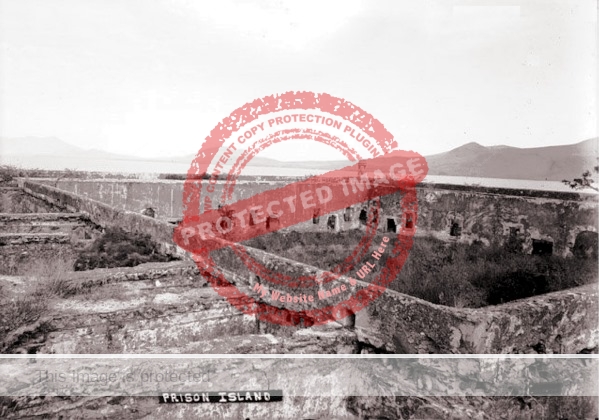We have looked previously at several excerpts from the journal written by Dr. Leo Leonidas Stanley (1886-1976) about his multi-day visit to Lake Chapala in October 1937.
On the morning of 15 October 1937—his final day before returning to Guadalajara—Stanley decided to take a two-hour launch trip with Alonzo, his traveling companion, to Mezcala Island, “six leagues from Chapala Village, and one of the points usually visited by tourists.”
Prior to being transformed into a penal settlement “for the captured criminals of Michoacán and Jalisco,” the island had witnessed the “first faint cry for Independence… [when] it was the theatre of many deadly conflicts between the harassed patriots and the royalists.”
Mezcala Island is the larger and more photographed of the two historically important islands in Lake Chapala. American photographer Winfield Scott took the first photos of the island that we know of, and was also responsible for the first organized tourist trips to Mezcala, advertised at the end of the nineteenth century.

Winfield Scott. c 1900. Prison Island (Mezcala Island). Credit: Fototeca Nacional INAH.
When he visited the island in 1937, Stanley found that:
The immense prison (presidio, a name often applied to the island), which dominates the lake for miles around, is falling into decay. An old care-taker and his decrepit wife are the sole occupants of the castle-like pile – which is perched on the crest of a commanding hill. The visitor may like to bear in mind that Mezcala has an unsavory reputation for alacranes [scorpions], the bite of which is often fatal. The fishermen say there is an alacran for every stone on the rocky island, and they usually warn visitors against these venomous pests.”
Stanley hired the boat “Corona” to take them to the island, and invited three newly found friends—Ysidoro Pulido and a couple of young boys—to accompany them. At the last minute, they were joined by a photographer, Andrade, and a “another boy of about fourteen years of age. This lad carried on his back a large gourd with a hinged door. In this gourd, he carried some of his photographic supplies.”
A strong wind was blowing from the east, and waves were dashing over our boat. The captain was a fat Mexican, about forty years of age, who wore a felt hat, but his two sailors looked like brigands, and wore their sombreros. The boat was about thirty feet long, and built of metal. The seats were some which had been removed at some previous time from an abandoned street car. They were covered with plush which had been badly torn.”

Leo Stanley. Excerpt from journal, page 75. Reproduced by kind permission of California Historical Society.
We arrived at the island about noon. It was a steep ascent through underbrush to the old presidio. The walls were intact but the roof had entirely disappeared, On one corner of the old jail was a modern faro, or lighthouse, which served as a beacon for the sailors on the lake. Inside the courtyard was a heavy growth of tropical vegetation, and it was difficult to work our way through…. There was much volcanic rock on the island, and in places there grew a very tough grass which was even too hard for animals to eat. It served for thatch on the building of the only inhabitants of the place, a Mexican and his wife with two young children. Inside the presidio was a small burro, the only animal, with the exception of a pig, which we saw. The old church near the northern end of the island was without a roof, and was so overgrown with vegetation that we were entirely unable to enter it.”
After returning to Chapala and partaking of an excellent lunch, Stanley caught the 4.00 pm bus to Guadalajara and reached his hotel, the Imperial, about two hours later.
My 2022 book Lake Chapala: A Postcard History uses reproductions of more than 150 vintage postcards to tell the incredible story of how Lake Chapala became an international tourist and retirement center. For a selection of earlier accounts of Mezcala Island and its history, see Lake Chapala Through the Ages.
Acknowledgments
My heartfelt thanks to Frances Kaplan, Reference & Outreach Librarian of the California Historical Society, for supplying photos of Stanley’s account of his time at Lake Chapala. I am very grateful to Ms Kaplan and the California Historical Society for permission to reproduce the extracts and photos used in this post.
Source
- Leo L. Stanley. “Mixing in Mexico.” 1937, two volumes. Leo L. Stanley Papers, MS 2061, California Historical Society. Volume 2.
Comments, corrections or additional material related to any of the writers and artists featured in our series of mini-bios are welcome. Please use the comments feature at the bottom of individual posts, or email us.
Tony Burton’s books include “Lake Chapala: A Postcard History” (2022), “Foreign Footprints in Ajijic” (2022), “If Walls Could Talk: Chapala’s historic buildings and their former occupants” (2020), (available in translation as “Si Las Paredes Hablaran”), “Mexican Kaleidoscope” (2016), and “Lake Chapala Through the Ages” (2008).